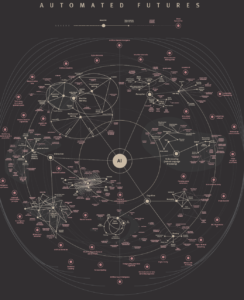Trying to discern its real future opportunity from its concrete threat as well as the current state-of-the-art of its research, proves to be rather difficult.
Opening spaces for ever-expanding and uncharted possible futures. Imperial Tech Foresight has built a map and a compass to navigate them, dabbling in both the fantasies of dream and the darkness of nightmare.
Since the coining of the term AI as a yet unspecified field of research in 1956, optimism of very different nature pervaded the field. Founders like Herbert Simon declared: “machines will be capable, within 20 years, of doing any work a man can do”. On the other side, philosopher Pamela McCorduck, wrote: “artificial intelligence began with an ancient wish to forge the gods”.
Beyond the hype, these quotes express a struggle between two very diverse tendencies – still present today in our imaginary – revolving around the nature and purpose of AI. One looks at its potential into automating human activities and work, almost emancipating humans from labour. The other, sees AI as a tool to augment human knowledge and expand its capacity to forge and control reality, in a novel “Faustian” deal with the devil.
Download our Automated Futures map by completing this form
What might be the destiny of AI?
As the question remains open, on one thing we can all agree. Along the way, the efforts to create AI systems have not only generated revolutionary tools that are impacting every aspect of science, healthcare and the economy, but have also increased insights on the nature of intelligence itself, as well as our own. AI research has branched in the domains of learning, vision, perception, interaction, language, reasoning, planning… (the list goes on) breaking down and trying to reproduce the very constituents of human experience.
Artificial intelligence began with an ancient wish to forge the gods – Pamela McCorduck
In our Automated Futures map – coming with a speculative dictionary – we plotted an ever-expanding universe inhabited by clusters of AI technologies and applications, both present and future, to explore their complexity and get inspired by what might be next.
applications, both present and future, to explore their complexity and get inspired by what might be next.
In the same way that the wanderer in the desert can use the stars and constellations to orient themselves in the dark, the AI wonderer can use our map to navigate technological futures that have yet to be realised, together with speculative intersections along the way that might generate unknown opportunities or unforeseen threats.
The possibilities to automate human tasks are as enticing (and threatening) as the capacity to extend human knowledge and take control over nature. As with any technology, its threat comes from misuse by humans.
Man + machine, not man vs machine
According to Antoine Cully, who was the lead academic that contributed to the map: “Rather than being a threat to humanity, AI systems are helping us protecting it”.
Former world chess champion and grand master Gary Kasparov, defeated by IBM’s Deep Blue in 1996, sees only one way: Human-machine collaboration.
AI Pioneer Stuart Russell, calls it Beneficial AI.
We hope you will enjoy your interstellar experience in the newly born universe of AI.